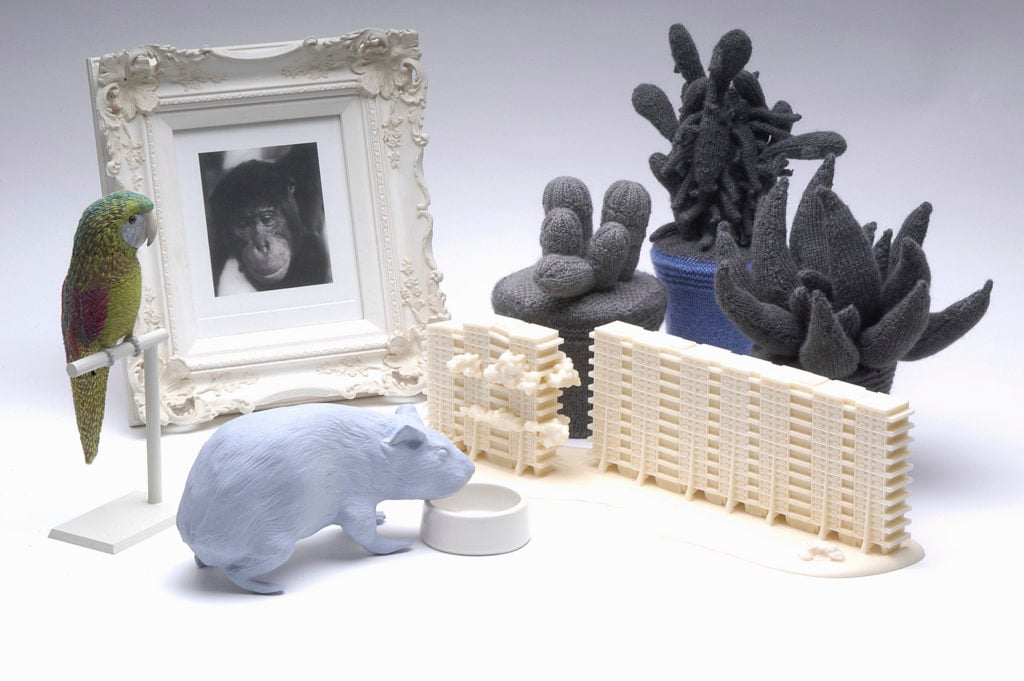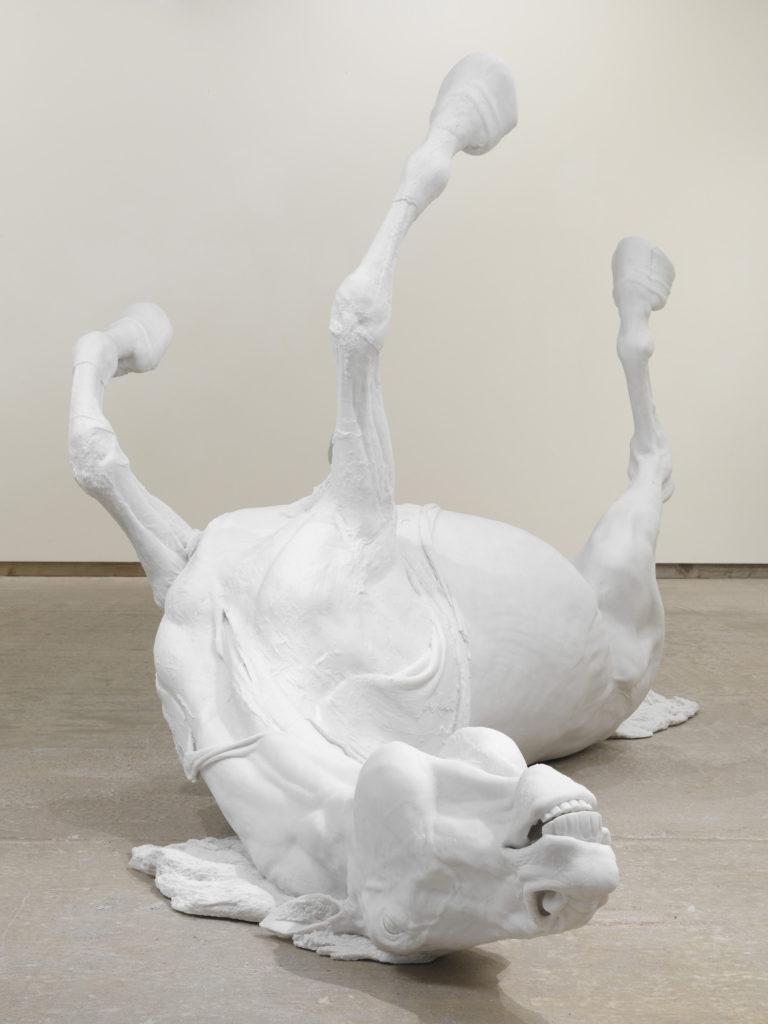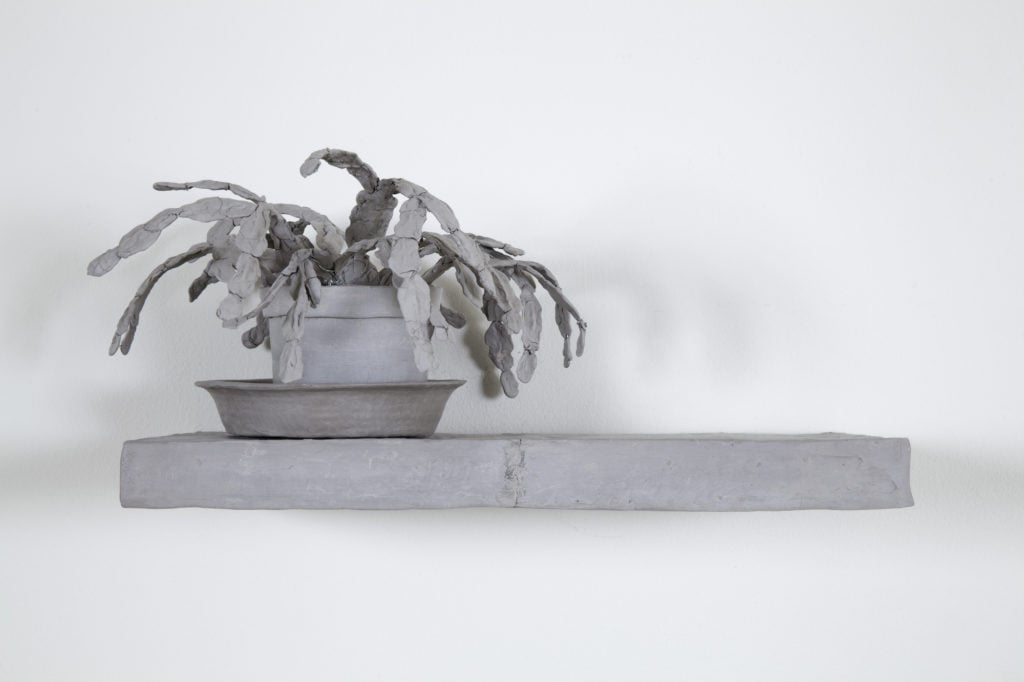Reviews
The Eerily Beautiful Sculptures of Daphne Wright Seduce at the Arnolfini
The etiolated works of the Irish artist explore emotions like solitude.

The etiolated works of the Irish artist explore emotions like solitude.

Lizzie Lloyd

Daphne Wright’s new show “Emotional Archaeology” at Arnolfini—with works also at Tyntesfield, the National Trust’s nearby Victorian Gothic Revival house—is almost entirely drained of colour. Instead, various shades of off-white, and sometimes pale grey, abound. Rather than being applied to the surface layers of her work colour is largely dictated by Wright’s materials: plaster, jesmonite, marble dust, tin foil, and unfired clay. What colour remains appears etiolated, sapped as if in death or blanched through a lack of direct sunlight.

Daphne Wright, Stallion (2014). Courtesy of the artist and Frith Street Gallery.
Such disquiet is a running theme through the show. First to greet you is a life-sized stallion lying supine, semi-flayed, grimacing, and contorted in agony. Its tongue hangs heavy, its legs kick at the air, its tendons taut, veins protruding, skin puckered. It’s horrific, but it’s also a technical tour de force. Cast in crisp white marble dust and resin it is a thing of beauty, worthy of a room to itself.
This graceful beast, its strength usually signalling imperial power in the history of art—from painting to public sculpture—is turned upside down: disempowered, in acute pain and on the brink of a horrible, and very public, death. Such allusions to the history of art, particularly to classical sculpture, are everywhere. The dark red on two sides of the gallery walls is a further—though distracting—reference to the works’ historic ancestry. The lamb strung up by its legs from a rod that protrudes into the gallery space conveys this message more succinctly, its reference to Francisco de Zurbarán’s Angus Dei (1635–40) undeniable.
Upstairs, the spell of the exquisite skill manifest in the marble sculptures is unexpectedly broken in Clay Heads (2014). Here, a troupe of flattened heads, with single holes or lines for eyes set atop low lying plinths receive you. Made of unrefined clay, these heads seem incongruous in their naivety, at odds with the detail and sophistication of Wright’s dead animal sculptures. It soon becomes apparent that they are here by way of introduction to the artist’s children.

Daphne Wright, Kitchen Table (2014). Courtesy of the artist and Frith Street Gallery.
Nearby the children’s forms are set around a kitchen table complete with table protector and pastel coloured checked oil cloth, all cast in jesmonite. It’s a quietly harrowing scene. One sits, slumped over the table, the other chair is unoccupied, the smaller of the two sitting cross-legged on the table. Most striking is what is not there. The boys are naked (but for a pair of underpants), bald, still and silent (in my experience unheard of on both counts). Kitchen Table (2014) is devoid of joy or family squabbles, or the attention of a carer; the familiar parental chastisements for sitting or slouching on the table made irrelevant. Colour here is hesitant, the boys’ skin ashen, making for a twilight effect, as if in mourning of time passing and memories fading into obscurity.
That sense of private isolation continues through to Domestic Shrubbery (1994). Around an intimate room a plaster cast of what appears to be floral flock wall paper is hung, jutting out at angles into the space. Wright, yet again, is intent on wrong footing you. What at first feels like a knowing nod to the use of flock wallpaper—once a luxury product, now more a cliché—is soon turned upside down as you notice the handful of anatomical hearts suspended in the midst of the tangled trellising. Meanwhile, a speaker sounds, featuring a woman mimicking the cry of a cuckoo over and over, in ever more desperate tones. It is oppressive, as if the walls are caving in around you, the cries of the cuckoo—a reminder of house clocks insistently punctuating silences—make you all too aware of your essential solitude in life.

Daphne Wright, Still Life Plant (2014). Courtesy of the artist and Frith Street Gallery.
The show is an unsettling proposition, though this effect is sometimes hindered by its hang, which is busy, perhaps to satisfy its billing as a retrospective. Some of its most successful curatorial moments actually happen outside of the galleries: a cabinet of small cast figurines and curios in the downstairs lobby, or the easy-to-miss clay household plant situated awkwardly above head height on the stairs. These connect what can feel like disjointed gallery spaces, making unexpected appearances that catch you pleasantly unawares.
Daphne Wright, “Emotional Archaeology” is on view at the Arnolfini, Bristol, from September 30 – December 31, 2016.